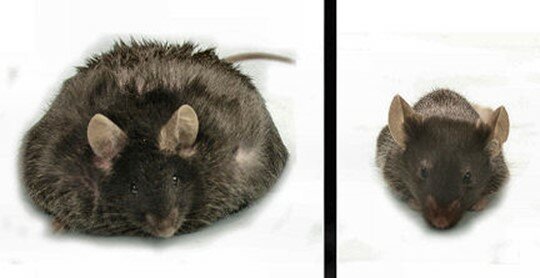
Take a look at this image of two mice. What difference do you see? The first thing that you might notice is that one mouse is bigger (and you would be right). The mouse on the left is over two times heavier than the mouse on the right.
What else is different about the two mice?
The answer might surprise you: not much else. The mice are the same species, live in the same environment, and (here is the kicker) they eat the same food. Not only do they eat the same food, they eat the same amount of food.
When you see two mice (or two humans for that matter) and one is larger, the first assumption we have is that the heavier one weighs more because they eat more. While this assumption is certainly true is some cases, more often obese mice eat no more food than non-obese mice.
When you discover there is no difference between the amounts of foods that a heavy or skinny mouse eats, then it is time to start scratching your head to try and figure out what is going on (especially when we are talking about our own weight loss).
There is clearly something different about those two mice, but what makes is it?
The answer is that scientists have engineered our fat mouse to gain weight. They tweaked the genes in the fat mouse to make him store fat. The interesting part comes when we discover just which genes they have changed.
Mouse Teaches us About Weight Loss
There are a few things that we can learn from our two mice.
The first is that if you want to create a mouse that gains weight, then you automatically engineered the mouse to have heart disease, diabetes, Alzheimer’s, and cancer. Scientists use these exact mice to study not only weight gain and weight loss, but also those other diseases. This means that these diseases are closely connected and they all may have the same underlying cause.
The second lesson is to understand exactly what scientist did when they tweaked the mouse genes. In order to create a large mouse, scientists choose to alter genes that change how the mice metabolize sugars. The large mice are insulin resistant, their bodies produce a large amount of insulin whenever they eat carbohydrates (and this brings us to the next point).
There is no way to grow such a large mouse without carbohydrates. Mice are omnivores (just like us) and if given a diet that is low-glycemic, high fat, or high in protein they would never grow so large. In order to build a fat mouse, scientists feed them mostly sugars. If you were to feed both mice in the above picture a high fat and protein diet, you wouldn’t be able to tell them apart.
What about Me?
While humans have escaped laboratory gene manipulation, most of us come from genetic stock that makes us very sensitive to sugars and foods that act like sugars in the foods that we eat. While we can bemoan the fact that we are stuck with genes that make us environmentally sensitive to sugars, there is nothing we can do to change our genes. We can, however, change our environment by changing what we eat (and that leads to weight loss).
Remember, without carbohydrates, there are no fat mice in the world; the same is true for humans.














My sister in on year 2 and feels so could. today is day one for me.
Good luck Janice!!
Dr. Scott